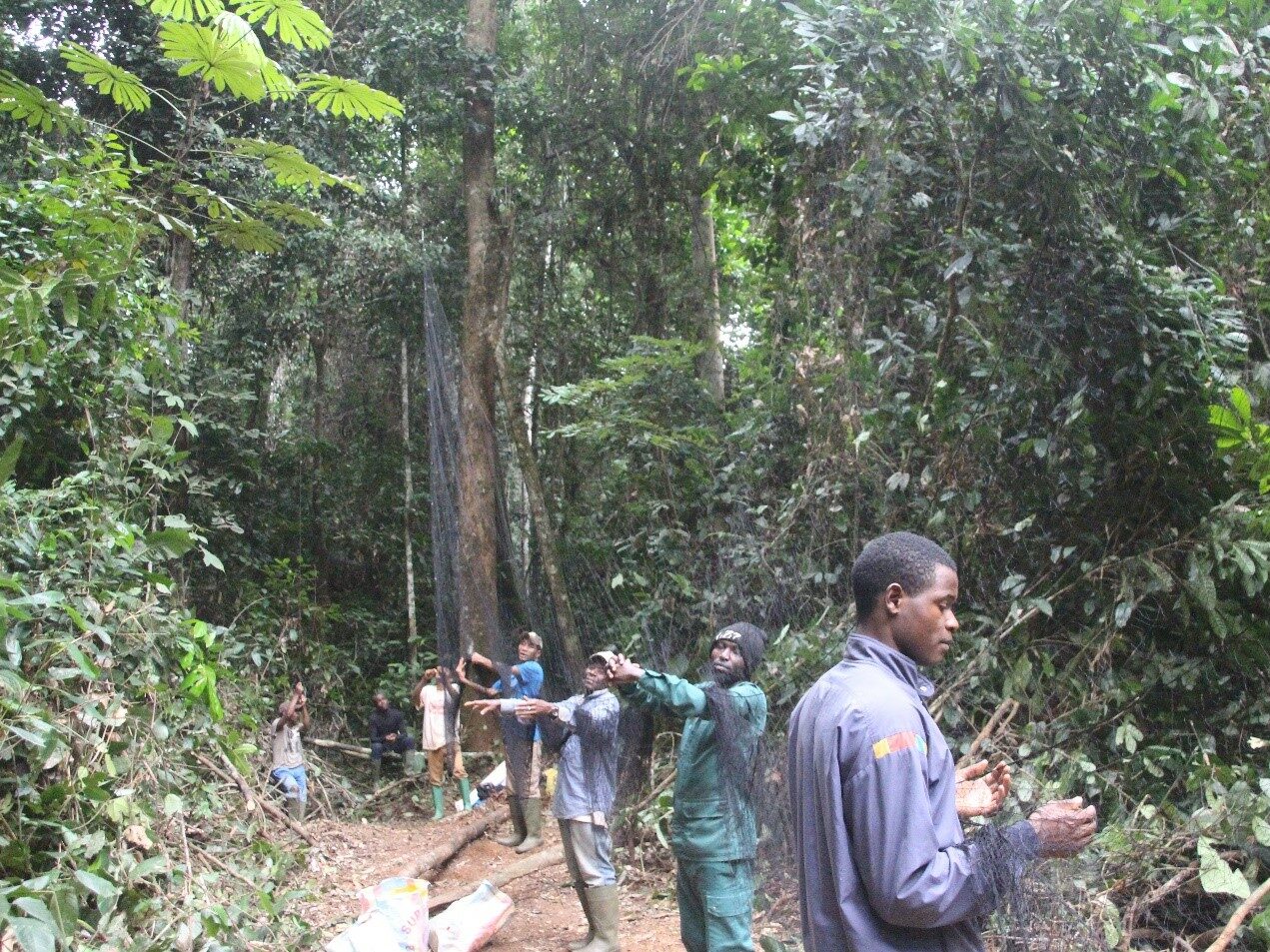Introduction
Fruit-eating birds of tropical canopies are often large, garish, and loud, but just out of reach for ornithologists. In 1993, my advisor, Dr. Tom Smith, trekked through the rainforests of southern Cameroon with Baka and Badwe’e forest guides hoping to learn more about the movement patterns and diet of hornbills—large, fruit-eating birds thought to be keystone seed dispersers of Central African rainforests. Much of what ornithologists can learn about birds requires holding them briefly in the hand, so how to bring them down from the canopy?


Black-casqued (Ceratogymna atrata) and white-thighed hornbills (Bycanistes albotibialis) rarely descend below the canopy, meaning mist nets needed to intercept their flight paths 30 meters (~100 feet) from the ground or higher. Dr. Smith, along with Master’s student Kimberly Holbrook and local Baka and Badwe’e forest guides, developed a pulley-mounted canopy net from older techniques described in previous papers and successfully tagged and tracked both species with radio tags. Nearly 30 years later, I revived “Projet Calao”—the Hornbill Project—for my PhD research on the feedback between rainforest vegetation structure and seed dispersal by hornbills. Although hornbills (Bucerotidae) had been captured and tagged in several parts of Africa and Asia by the time I began the project, capture details and modifications to cited methods were rarely reported.
We decided to describe our technique in full detail so that researchers can continue studying these species without a special training session at the beginning of each project. The product is a paper describing how to capture large, fruit-eating birds of rainforest canopies.
The technique
The canopy net is actually four 12-meter mist nets attached bottom-to-top with trammel line and attached to two rotating nylon net lines that bring the “net wall” to a top line as part of a pulley system with steel rings. The top line rests on two tree limbs on opposite sides of a tree whose fruits the hornbills can’t resist.
Before I go on, I should mention that the real canopy net experts are several forest guides from villages in southern Cameroon. In a green sea of more than 200 tree species, the Baka and Badwe’e guides expertly identify the trees that attract hornbills and satisfy the criteria of a good net location. The ideal net is raised level with the crown of a tree producing a massive crop of fruits and attracting dozens of our target bird species, while concealed well by vegetation. Net locations usually incur a tradeoff among these characteristics.
We fall into a rhythm while constructing each net, with every team member—up to 11 for a given field expedition—filling a role. We use a collection of Baka, Badwe’e, English, and French terms to set up the nets. “Dara” = “pull,” “filet” = “net”, “scotch” = “duct tape,” “djoku” = “good.” Forest guide Daniel Dando often found the best trees for net locations, and Armand Abah was usually the one to slingshot a fishing weight around the branches in the canopy that eventually supported the top net line. Université de Yaoundé I Master’s student Antoine Tekam contributed the perfect slipknot for the net cords, which need to be tied to nearby saplings in a way that enable one to undo it quickly once a bird is in the net. Once the pulley mechanism is in place with the net attached, we bunch the netting in a plastic bag and place it within understory vegetation for the night.
The next morning, the net needs to go up in the thin window of time between the retreat of the nighttime bats and the arrival of the first hornbill, usually at 5:52 a.m., give or take. I leave that decision up to an experienced guide, who scans the canopy periodically with a red headlamp, looking for bats fluttering in the net lane. When I hear the first hornbill squawk of the morning, I practically jump out of my skin—time to raise the net.
Capturing hornbills and other large canopy birds requires exceptional patience. Two or three team members sit near separate ends of the net, ready to undo the net cords when a bird falls into a net pouch. We conceal ourselves behind a hunting blind of sorts, made from the natural understory and branch trimmings left over from clearing the net lane. This makes it harder to see the entire net, and so, from my seat, I resort to rocking around and craning my neck to follow a hornbill in a tree, fully engaging my core muscles. Birders in temperate North America often complain about “warbler neck”. Surely, they can imagine “hornbill neck,” which comes from staring at hornbills in the Central African rainforest canopy morning after morning.


What we found
Hornbills can make your heart leap, barely grazing the top net line before landing safely in an étengué tree to crack open fruit after fruit, toss the seeds and arils down their throats, and drop the husks noisily to the ground, only to fly away none the wiser of the net location.
Other days, you can hear the loud, whooshing wingbeats approach from exactly the right direction, and then suddenly, one or two birds tumble into a net pocket. That’s when the team explodes into action, slipping the net lines off the saplings and collapsing the net in one careful motion before lowering the netted bird to the ground. That’s when I secure the bird’s massive bill and lock eyes with the dinosaur-like creature that would otherwise be a perilous climb or helicopter flight away.
In three separate project phases (1993-1996; 2009, 2022-2023) we captured 33 black-casqued and 28 white-thighed hornbills, 10 African green-pigeons, and four great blue turacos. We even used the technique to capture some non-feathered animals, including 11 hammer-headed and five Egyptian fruit bats. We normally captured one to five hornbills in a week, and usually no more than three in the same net. Our technique enabled the two net lines to operate independently, allowing us to quickly and safely collapse the netting around a captured hornbill and maneuver the netting around vegetation from the canopy to the ground.
Why it’s important
Tropical rainforest canopies are rich in 3D complexity, with intertwining branches forming “highways” for birds, mammals, amphibians, insects, and other organisms. Considered a frontier in biological research, tropical canopies are difficult to study because they can reach 60 m (~200 feet) or higher. In tropical latitudes, most tree species rely on animals to disperse their seeds. Understanding the distribution, habitat requirements, and especially the movement behavior of canopy frugivores is critical for informing the protection of tropical rainforests. The technique described in our paper can bring them safely down from the canopy for projects that fill gaps in tropical forest data collection. If you should build a net in the rainforest canopy, remember it is a team exercise, and include local community members as part of your team. Local “professors of the forest” are the world’s experts on tropical forests and are key to preserving the magnificent flora and fauna of the canopy.

Video of the technique
Nicholas Russo
PhD Candidate, Ecology and Evolutionary Biology
University of California, Los Angeles
The results of this study were recently published in the Journal of Field Ornithology:
Russo, N. J., K. M. Holbrook, T. V. Dietsch, F. A. Forzi, A. S. A. Tekam, and T. B. Smith. 2024. A maneuverable canopy net for capturing large tropical birds. Journal of Field Ornithology 95(1):13.. https://doi.org/10.5751/JFO-00438-950113.
Header photo: Black-casqued hornbills (Ceratogymna atrata) by Ondrej Prosicky | Getty Images.
